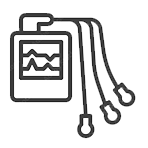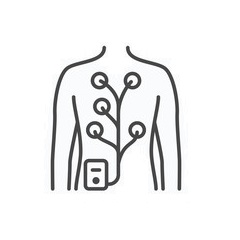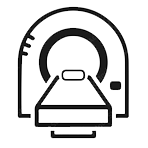Coronary Calcium Scan
The overall area of calcium deposits and the calcium density are taken into account while calculating the score. In the presence of calcium, a higher score is associated with a higher risk of cardiovascular disease.
Q & A
Coronary calcium scans use computed tomography (CT), a special kind of X-ray, to look for calcium buildup in plaque on the walls of the heart’s arteries (coronary arteries). This test is used to find heart disease early on and figure out how bad it is. Coronary calcium scans are also called cardiac calcium scoring.
Blood gets to the heart muscle through the coronary arteries. Usually, calcium is not found in the coronary arteries. Calcium in the coronary arteries could be a sign of coronary artery disease (CAD).
During a CT scan, thin slices of pictures of the heart are taken. The pictures are saved in a computer, where they can be looked at again or printed out as photos.
Health Tools help you make good decisions about your health or take steps to improve it.
Decision Points focuses on important decisions about medical care that are important for many health problems.
Should I get a calcium scan of my heart?
Your doctor may want you to get a coronary calcium scan if it can help you and your doctor decide how to lower your risk of heart disease, heart attack, and stroke.
This test might be most helpful for people who don’t have heart disease but are at a medium risk of getting it. Your doctor can help you find out how likely it is that you will get heart disease, a heart attack, or a stroke. Your doctor will look at things that put you at risk, such as your age, gender, race, blood pressure, cholesterol, and diabetes.
A coronary calcium scan is not a good way to check for coronary artery disease on a regular basis.
footnote 1: This test may not tell your doctor more about your risk for heart disease than your risk factors do.
You should not take this screening test if:
- You don’t have any heart disease risk factors, so your chances of having a heart attack or stroke are low.
- You have a high chance of getting heart disease, or you already have it. (You should be seeing a doctor already.)
- If you are a man under 40 or a woman under 50, this test might not be right for you. This is because the arteries of most young people don’t have a lot of calcium buildup yet.
How to Do It
You will have to take off any jewellery that could get in the way of the X-ray. You may need to take off some of your clothes. During the test, you will be given a gown to wear if this is the case. Some CT scans may let you keep your clothes on. If so, wear loose clothes with no snaps or zippers.
On your chest, small pads or patches called electrodes will be placed. These are wired to an EKG machine, which writes down the electrical activity of your heart. The EKG shows when your heart is at rest, which is the best time for CT scans.
During the test, you will lie on a table that is connected to the CT scanner. The scanner is a big machine in the shape of a donut.
The table slides into the machine’s round opening, and the scanner follows your body as it moves. Every few seconds, the table will move a little bit to take a new picture. As the table and scanner move, you may hear clicks or buzzes.
Taking pictures of your heart may require you to hold your breath for 20 to 30 seconds. It is very important to stay completely still while the pictures are taken.
Most of the time, you are the only one in the scanner room during the test. But during the test, the technologist will watch you through a window and talk to you.
What It’s Like
A calcium scan of the heart takes around 30 minutes. You won’t have any pain from the X-rays during the coronary calcium scan. But the table you lie on may be hard, and the room may be cool. It might be hard for you to lie still for a long time.
Risks
There is not much of a chance that a coronary calcium scan will cause a problem. Even the small amounts of radiation used in CT scans, X-rays, and other medical tests can cause damage to cells or tissue. Radiation can cause cancer and other health problems if you are exposed to it for a long time. But the chance of getting cancer from small amounts of radiation is low most of the time. Most people shouldn’t avoid these tests because of this.
A coronary calcium scan can’t find soft plaque because it isn’t hard. Soft plaque is the earliest form of damage to the arteries of the heart. If your arteries have soft plaque, the test may show that everything is fine, but this is a false-negative result. A heart attack can also be caused by the buildup of soft plaque.
Results
Your calcium score is a number that comes from the test. From 0 to more than 400, the score can be. The more points you get, the more likely you are to have a heart attack. If you aren’t sure if you should take a statin to lower your risk of a heart attack, the score might help you decide. Your doctor will look at your calcium score, as well as your age, your health, and the results of other tests, such as your cholesterol level. footnote2 Test Overview
Coronary calcium scans use computed tomography (CT), a special kind of X-ray, to look for calcium buildup in plaque on the walls of the heart’s arteries (coronary arteries). This test is used to find heart disease early on and figure out how bad it is. Coronary calcium scans are also called cardiac calcium scoring.
Blood gets to the heart muscle through the coronary arteries. Usually, calcium is not found in the coronary arteries. Calcium in the coronary arteries could be a sign of coronary artery disease (CAD).
During a CT scan, thin slices of pictures of the heart are taken. The pictures are saved in a computer, where they can be looked at again or printed out as photos.
Health Tools help you make good decisions about your health or take steps to improve it.
Decision Points focuses on important decisions about medical care that are important for many health problems.










